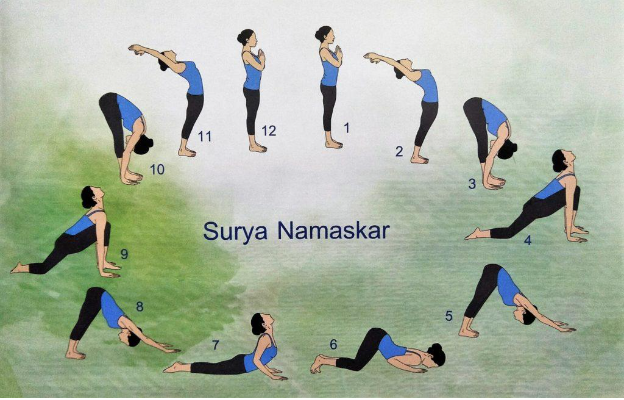What is Shashankasana (Rabbit Pose) and its Benefits? Shashankasana is a simple forward-bending posture that provides a gentle stretch with relaxes and energizes the mind and body. Shashankasana help to stimulate the activity of the endocrine glands and digestive organs in the body, regulate hormone levels, and maintain balance. The Shashankasana is a popular pose for curing back problems (Join our yoga school in Rishikesh) and when practiced regularly can be a boon to tired backs and those with back problems. It is a beginner’s pose and can be performed by people of all ages.
“Yoga means addition – addition of energy, strength, and beauty to body, mind, and soul.”
― Amit Ray
- What is Shashankasana (Rabbit Pose)
- Benefits of Shashankasana (Rabbit Pose)
- How To Do Shashankasana (Rabbit Pose)
- Beginners Tips for Shashankasana (Rabbit Pose)
- Preparatory Poses for Shashankasana (Rabbit Pose)
- Steps for Shashankasana (Rabbit Pose)
- Follow-Up Poses of Shashankasana (Rabbit Pose)
- Precautions and Contraindications for Shashankasana (Rabbit Pose)
- Advance Poses or Variations of Shashankasana (Rabbit Pose)
- What is the main purpose of Shashankasana?
What is Shashankasana (Rabbit Pose)
Shashankasana or rabbit pose is also known as the moon pose and the hare pose. Shashankasana is derived from the Sanskrit word Shashank, which means moon. As the moon symbolizes peace and calm, Shashankasana offers similar soothing and cooling effects on the practitioner. Therefore, it is known as Moon Pose.
On the other hand, Shashankasana is a position that rabbits and hares take frequently. So, it is called a Hare pose or Rabbit pose in additional also, Shashankasana is further split into three words: shash, ank, and asana which means:
- Shash – hare or rabbit
- ank – lap
- asana – pose or posture
Shashankasana is pronounced as sha-sha-ankh-as-ana.
While seated on the knees, Shashankasana is a forward bend, which stretches out the neck and the hips as far as they can go. Hence, it can be used in flow yoga sequences to boost energy levels.
Benefits of Shashankasana (Rabbit Pose)
Shashankasana or rabbit pose holds multiple benefits for the mind and body. Below, some of the benefits are listed that you can (Join our yoga teacher training in Rishikesh) get by performing Shashankasana are as follows:
- Relief Stress
- Improve memory and concentration
- Cure Sexual Disorder
- Get Facial Glow
- Improve Hair Health
- Improve posture
- Reduce Belly Fat
- Control Diabetes
- Decrease Anger
- Cure Common Aches
- Massage Abdominal
Now, discuss how we get these benefits by performing Shashankasana are as follows:
- Relief Stress
Practicing Shashankasana acts similarly to a panacea for stress, so it is recommended that anyone with stress, anxiety, anger, tension, etc., perform the pose religiously.
- Improve memory and concentration
To improve memory and concentration, practicing Shashankasana or rabbit pose properly ensures the smooth flow of blood towards the skull.
- Relief Sexual Disorder
For people with sexual disorders, it strengthens the pelvic region, is good for women, and relieves sexual disorders. Both male and female reproductive organs benefit from it.
- Get Facial Glow
Regular practice of Shashankasana increases blood flow to the face, Ashankasana also helps to enhance the facial glow.
- Improve Hair Health
Regular practice of Shasankasana regulates blood flow into the hair follicle, which prevents graying of hair, hair fall and is good for hair health.
- Improve posture
As you stretch your back in Shashankasana, you align your spine, and as you come out of the pose, you may notice that your spine has grown. This assists in improving posture.
- Reduce Belly Fat
Regular practice of Shashankasana helps reduce belly fat by stretching the abdominal region against the thighs.
- Control Diabetes
The Shashankasana is the best (Join our 200 hour yoga teacher training in Rishikesh) for relieving constipation and controlling diabetes.
- Decrease Anger
Regular practice of Shashankasana calms the brain and eliminates or decreases anger.
- Cure Common Aches
Practicing Shashankasana helps prevent and cure headaches, neck pain, and backaches, the rabbit pose is recommended for people who suffer from these conditions.
- Massage Abdominal
Massage the abdominal organs according to their needs and prevent constipation and indigestion.
After Know about the benefits of Shashankasana now move to how to do Shashankasana or Rabbit pose correctly:
How To Do Shashankasana (Rabbit Pose)
It is important to know the correct step-by-step procedure, beginner tips, preparatory poses, follow-up poses, precautions, and contradictions of the asana to avoid any kind of injury and to fully benefit from the asana. So, here first we discuss some of the beginner’s tips for Shashankasana are as follows:
Beginners Tips for Shashankasana (Rabbit Pose)
For beginners, here are some of the beginner’s tips you should know before performing Shashankasana are as follows:
- In the beginning, at Shashankasana position, most people tend to lift their buttocks until they touch the ground with their forehead. Don’t lift it.
- You should only move as far as you can comfortably without straining and lifting your body.
- Make sure to perform Shashankasana on an empty stomach.
- As you breathe, you move.
- Avoid Shashankasana if you feel dizzy or have a backache or pain in the legs.
Preparatory Poses for Shashankasana (Rabbit Pose)
Shashankasana or Rabbit Pose is very easy to learn and it is not required to practice any preparatory poses, you can directly do it after warm-up also. However, a bit of practice will make the task easier and injury-free. So, (Join our 300 hour yoga teacher training in Rishikesh) below listed some of the preparatory poses are as follows:
- Dandasana – Staff Pose
- Vajrasana – Thunderbolt Pose
Steps for Shashankasana (Rabbit Pose)
Here are the step-by-step procedure to practice Shashankasana correctly are as follows:
- Sit in the Vajrasana (Thunderbolt Pose).
- Breathe Normally: Put your hands on your knees.
- Now, spread both of your knees apart in a comfortable position as far as possible.
- Make sure the toes of your feet touch each other.
- Now, keep your palms in between your knees and face forward.
- Now Exhale: Strech your palms forward and also bend your body forward.
- Make sure your hands are parallel to each other and your chin is on the floor.
- Breathe Normally: Keep looking in front and remain relaxed to the pose for 30-60seconds. This is Shashankasana or Rabbit Pose.
- Inhale: Come up and straighten your body.
- Now Exhale: Come back to Varajasana(As in Step 1).
Duration: In the beginning, hold the Shashankasana(As in Step 8) for one minute; gradually extend it to three to five minutes.
Follow-Up Poses of Shashankasana (Rabbit Pose)
As any forward bending pose should be followed with a backward bending pose. So, after the Shashankasana there also follow backward bending pose. Below, some of follow up poses are listed for Shashankasana or rabbit pose are as follows:
- Vishramasana – Pose Dedicated To Sage Vishram
- Bhujangasana – Cobra Pose
- Dhanurasana – Bow Pose
- Setu Bhandasana – Bridge Pose
- Ushtrasana – Camel Pose
Precautions and Contraindications for Shashankasana (Rabbit Pose)
The precautions and contradictions for Shashankasana or rabbit pose that should be taken should be kept in mind so a safer practice (Join our 500 hour yoga teacher training in Rishikesh) can be carried out are as follows:
- Pregnant women must avoid practicing Shashankasana at all costs.
- Shashankasana should be avoided if you have a knee injury, spinal injury, shoulder injury, or neck pain.
- A person who has suffered a neck injury should not look at the floor and keep the head in a neutral position.
- Osteoarthritis patients should use caution when doing Shashankasana
- Shashankasana should not be practiced by anyone suffering from any of the following conditions:
- vertigo,
- high blood pressure,
- knee problems
- slipped disc.
Advance Poses or Variations of Shashankasana (Rabbit Pose)
There are many variations of Shashankasana or rabbit pose due to its flexibility are given below:
- Variation 1: Only the arms position differs. Placing the hands at the back rather than placing them at the front. Holding the left wrist with the right hand.
- Variation 2: It is performed when you master variation 1, Just arms position differs in this too. Keep your fists under your lower abdomen.
What is the main purpose of Shashankasana?
The main purpose of Shashankasana is to stretch the back will relieve back muscles, tone pelvic muscles, and alleviate disorders of both the male and female reproductive systems.




